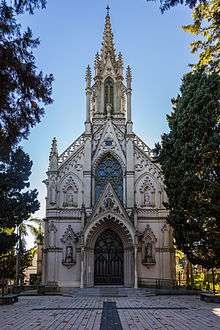Sagrada Familia, Montevideo
The Church of the Holy Family (Spanish: Iglesia de la Sagrada Familia), also known as Capilla Jackson, is a Roman Catholic parish church in the neighbourhood of Aires Puros, Montevideo, Uruguay.[3]
| Sagrada Familia (Capilla Jackson) | |
|---|---|
 | |
| Religion | |
| Affiliation | Roman Catholic |
| Ecclesiastical or organizational status | Parish church |
| Year consecrated | 1870[1] |
| Location | |
| Location | Carlos Vaz Ferreira 3711 Montevideo, |
| Architecture | |
| Architect(s) | Víctor Rabú[1][2] |
| Type | Church |
| Style | Neo-Gothic |
| Completed | 1870 |
History
The temple was built as a private chapel for the Jackson family; designed by French architect Víctor Rabú in nt]] Neo-Gothic style,[4] it was the edifice religious was built and consecrated in the year 1870.[1] Currently it is a parish church held by the Jesuits.[5]
The parish was established on 16 April 1961.[3] In 1975 it was declared a National Historical Monument.[1]
The remains of businessman Juan D. Jackson are buried here.
gollark: Even if you can live entirely on those, it would be unhealthy and thus worsen the slaves, and producing that at the necessary scales would still be polluting.
gollark: But climate change is caused by greenhouse gases, which slaves produce, as does their food production.
gollark: Unfortunately, nuclear physics was poorly understood at that time, and they didn't have the necessary technologies to make much use of it in any case.
gollark: They can do some object manipulation tasks which computer things can't, which is useful in slavery I guess, but most of the useful features of humans versus robots or computer systems are in high-level and abstract thinking, which slavery underutilizes.
gollark: And they're inefficient and bad at menial labour.
References
- "Capilla Jackson". Intendencia de Montevideo. Retrieved 8 May 2013. (in Spanish)
- "Historicist fervor". EL PAIS. 13 April 2003. (in Spanish)
- "Capilla Jackson". Archdiocese of Montevideo. Retrieved 30 March 2013. (in Spanish)
- César J. Loustau (1995-01-01). Influencia de Francia en la arquitectura de Uruguay. Ediciones Trilce. p. 48. ISBN 9974-32-116-6. (in Spanish)
- "Institutes of consecrated life in Uruguay". Archdiocese of Montevideo. Retrieved 28 April 2013. (in Spanish)
This article is issued from Wikipedia. The text is licensed under Creative Commons - Attribution - Sharealike. Additional terms may apply for the media files.